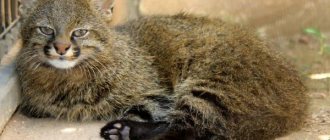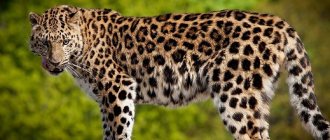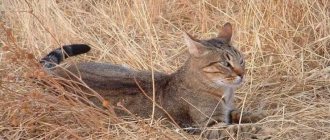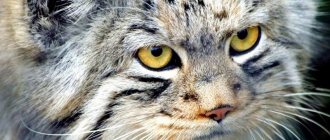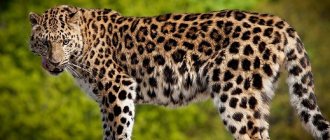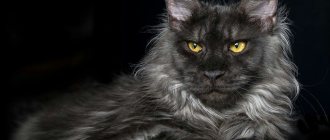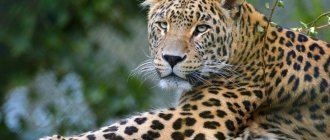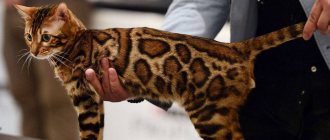External description
The Asian predator has an unusual color. The main background of the coat can be straw-brown, up to a dark grayish tint. The fur on the face is white, with black markings located on the forehead and cheeks. The belly and short legs are decorated with oval spots of charcoal color.
In babies up to six months old, the spots on the sides are solid, differing in brightness. In older animals, the spots take on the shape of an ellipse with light hair in the center. The back group of spots is slightly different in color intensity from the front; they are darker and more expressive.
The height of the animal, measured at the withers, ranges from 50-60 cm. The total length of the body (with head, but without tail) is 75-100 cm, the tail has the same length as the whole body - up to 90 cm. Weight of adult pets averages 20 kg. Females differ slightly in size from males, that is, the severity of sexual dimorphism is not observed.
The external features of clouded leopards are as follows:
- The eyes are beautiful yellow or gray-green, vigilantly watching for prey. The pupils, like all representatives of the cat family, are vertical.
- The length of the fangs varies from 3.5 to 4.5 cm, but there are also longer specimens. If we compare the length of the fangs and head, as well as the dimensions of the body, it turns out that clouded leopards have the longest fangs.
- Nose – has a pink color, sometimes there is black spotting.
- A characteristic feature of this animal species is its short legs. Rear limbs much longer than the front legs. Claws this wild cat's are retractable and of impressive size. The leopard of this species belongs to the digitigrade species.
Existing subspecies
It is customary to distinguish animals according to existing species:
- the nebulosa species is distributed in southern China, as well as in the eastern lands of Myanmar;
- macrosceloides is another subspecies found in Myanmar, also found in Nepal.
Until 1990, there was a Taiwanese subspecies, which is now considered extinct.
Literature
- Christiansen, Per: Species distinction and evolutionary differences in the clouded leopard (Neofelis nebulosa) and Diard's clouded leopard
.
In: Journal of Mammalogy December 2008: Bd.
89 , Ausgabe 6, pp. 1435–1446. - Kitchener, A. et al. (5. December 2006): Geographical Variation in the Clouded Leopard, Neofelis nebulosa, Reveals Two Species
.
In: Current Biology 16 (23)
, S. 2377–2383. - Sunquist, M.E. & F.C.: Family Felidae (Cats)
In: Don E. Wilson & Russel Mittermeier (Hrsg.)
Handbook of the Mammals of the World Volume 1: Carnivores
. Lynx Editions. 2009. S. 127. ISBN 978-84-96553-49-1
Best articles: What is a fjord called in geography? Definition and examples
Habitat and distribution of the subspecies
Clouded leopards live on the southern slopes of the Himalayas in Nepal and Bhutan, as well as in the Indian northeastern regions. Wild cats with smoky colors can also be found in the south: Myanmar, Thailand, Vietnam, Malaysia.
Most often, clouded leopards can be seen in tropical forests located at least 3 thousand meters above sea level. These predators are capable of hunting not only on the ground, but also cope well with animals living in trees. Sharp claws and powerful limbs allow them to climb high up tree trunks. By the way, wild cats not only hunt on the tops of trees, but also rest.
Tropical forests are not the only habitat of clouded leopards. They can be found in mangrove swamps and swampy forests. Dry tropical forests and grasslands can also pose the risk of encountering predatory animals. Even coastal areas are not immune to leopard infestations.
Lifestyle
Early observations showed that this is a very secretive animal, leading a nocturnal lifestyle. However, later studies based on camera trap data partially refuted the previous conclusions of zoologists. It turns out that clouded leopards are active both during the day and at night. They are less active at midday, but dusk and the pre-dawn hours are theirs at any time of day.
Photo: Shady Ramzy
The clouded leopard spends most of its time in trees. It rests in the trees until dark and then descends to the ground to hunt wild boar and muntjac, which usually go to bed after sunset.
Clouded leopards lead a solitary lifestyle . This is another reason why they are difficult to observe. The habits of these animals probably depend on the presence of other predators and the proximity of human settlements.
Pregnancy and childbirth
It is not possible to observe mating in natural conditions, so all conclusions are drawn from observations of pets living under human supervision. Breeding in captivity often involves danger to the life of the female.
Males behave so aggressively during mating that they bite the female’s neck.
This usually happens if the male and female were kept in different enclosures before the act of acquaintance. When living together, matings are much more effective. This fact suggests that animals are monogamous, but scientists do not confirm such a hypothesis.
The process of copulation in a zoo most often occurs in the winter months or early spring. But this does not mean that animals do not mate during other periods. Matings are possible throughout the year. During flirting, the male bites the female's withers and begins sexual intercourse, while the female makes drawn-out sounds. Copulation occurs many times.
Under natural conditions, animals choose elevated areas for mating, from the slopes of which the moaning, drawn-out sound of a satisfied female echoes. From the moment of conception to delivery, it takes from 85 to 95 days, the timing is arbitrary and can shift both smaller and larger.
Pregnancy in a female is indicated by a rounded belly by the third trimester and enlarged nipples. There are from 1 to 5 babies in a litter, but most often 2 cubs are born in captivity. The weight of the baby when born is only 100-140 g, this figure also changes and depends on the number of babies in the litter. Newborn pets are born with their eyes closed; only after 10 days do they “see the light.”
Babies begin to walk around the 4th week after birth. 1.5 months after birth, little leopards perfectly master heights and climb trees without fear. The ability to hunt in babies awakens quite early. Already at 2-3 months they are capable of killing a bird, chicken or small rodent. Newborn babies are licked by their mother and fed with milk; this is the only nutrition that kittens receive from their mother until they are two months old.
At the age of two months, babies can already switch to meat, refusing mother's milk. The female begins to bring small prey from the hunt, which she feeds to the cubs. Until they reach ten months of age, children live under maternal care. She teaches them the wisdom of hunting and feeds them with her own prey. By the age of one year, animals are able to live separately and find their own food.
Pets reach sexual maturity at 24 months, but the figure can range from 20 to 30 months. In captivity, leopards produce litters no more than once a year. Male leopards are naturally selfish. After copulation, the couple separates, and only the mother is involved in raising the babies and feeding them. Males do not participate in the process of training their offspring.
Reproduction
For most of their lives, animals prefer to live alone. Each predator has its own hunting area. It stretches for tens of kilometers. Males begin to actively search for companions only during the breeding season.
After successful mating, the female carries the cubs for three months. A hollow in a tree is chosen as a place for raising offspring. Several kittens are born there, usually about one to five. The weight of each rarely reaches two hundred grams. Babies open their eyes at 10-12 days of life. Development is quite slow. The cubs begin to walk independently twenty days after birth. The complete transition to meat food occurs at ten and a half weeks. However, for another five months, babies can receive breast milk. They begin to lead an independent life at nine months. Full puberty occurs at twenty to thirty months.
Immediately after they are born, kittens' fur is yellowish-gray in color, but by six months it becomes spotted.
In captivity, reproduction can be too unpredictable. Due to the fact that males live in a limited territory, they are too aggressive. In 80% of cases after mating, they attack their companions. Females often die. Not all surviving cats produce offspring. However, zoos continue to try to revive the captive population. Thus, practice has shown that raising individuals of both sexes together reduces the aggressiveness of males
It is important that the couple live together from an early age, when the animals are not yet one year old. Not every zoo can afford this.
There are researchers who are inclined to carry out further reproduction through artificial insemination and embryo transfers. This way you can save the lives of females and get healthy offspring.
Basic diet of wild cats
Carnivores are carnivores and feed on various types of birds, fish, small animals and rodents. All animals smaller than clouded leopards and living in the same territory as them can end up in their teeth. The exception is other predators that live on the same lands.
The main diet consists of:
- wild boars;
- gophers;
- macaques;
- loris;
- pork deer;
- fish from local waters.
Predators do not disdain domestic animals; they attack pigs, kids, calves, cats, and dogs. Their signature bite is on the back of the neck.
Notes
- Valerie A. Buckley-Beason, Warren E. Johnson, William G. Nash, Roscoe Stanyon, Joan C. Menninger, Carlos A. Driscoll, JoGayle Howard, Mitch Bush, John E. Page, Melody E. Roelke, Gary Stone, Paolo P. Martelli, Ci Wen, Lin Ling, Ratna K. Duraisingam, Phan V. Lam & Stephen J. O'Brien: Molecular Evidence for Species-Level Distinctions in Clouded Leopards.
In:
Current Biology
, number 16, December 5, 2006, pp. 2371–2376. - Bo Beolens, Michael Watkins, and Mike Grayson.
The eponym dictionary of mammals. - Baltimore: The Johns Hopkins University Press, 2009. - P. 110. - 574 p. — ISBN 978-0-8018-9304-9.
Lifespan
The lifespan of predators is about 11 years. There are many dangers in the wild that can shorten the lifespan of clouded leopards. These include forest fires, human activity, leading to the destruction of natural habitats, as well as larger predators that can attack.
In zoos with good care and nutrition, pets live up to 15-17 years. No specific diseases that shorten the life of clouded leopards have been identified, since no research has been conducted in this area.
Nutrition
The clouded leopard is a 100% predator. Its diet includes both small and fairly large mammals. These may include:
- Birds and fish;
- Monkey;
- Deer;
- Rodents;
Favorite prey for this species are: Argus pheasant, wild boar, Javan pangolin and Himalayan civet. These animals kill their prey with one bite to the neck.
Clouded leopard cub
This is interesting: TOP 10 Mothers in the animal world
Habits of predators
Spotted leopards hunt most often in the dark; their eyesight and dexterity allow them to do this. The special structure of the limbs and body allows predators to overtake prey right on the treetops. Short legs and a long tail help the leopard to masterfully perform real acrobatic performances.
These animals are capable of descending from trees upside down, hanging on branches, clinging to their hind limbs. Such physical characteristics make it possible to kill birds gaping on the branches. Trees serve as a place of rest and escape. In tropical thickets there is a special type of leeches that can ruin the sleep of wild cats, and tree branches are dry and relatively safe.
On the spreading crown you can escape from larger brothers that pose a threat to life. Leopards and tigers are not averse to chasing smoky animals through the forest, so trees are an excellent refuge for the latter.
Leopards of this species do not live in packs; they can be called solitary animals. To reproduce, the male finds a suitable female, and after her fertilization he disappears from sight. In the wild, you can see a female with cubs, which, after growing up, leave their native territory and settle in a new place.
The territory inhabited by 1 representative of this family is approximately 35 square meters. km. The area that is actively used is from 2 to 5 square meters. km. The habitats of females and males are approximately the same in size. In addition, the ranges of animals of the opposite sex partially overlap.
Literature
- Christiansen, Per: Species distinction and evolutionary differences in the clouded leopard (Neofelis nebulosa) and Diard's clouded leopard
.
In: Journal of Mammalogy December 2008: Bd.
89 , Ausgabe 6, pp. 1435–1446. - Kitchener, A. et al. (5. December 2006): Geographical Variation in the Clouded Leopard, Neofelis nebulosa, Reveals Two Species
.
In: Current Biology 16 (23)
, S. 2377–2383. - Sunquist, M.E. & F.C.: Family Felidae (Cats)
In: Don E. Wilson & Russel Mittermeier (Hrsg.)
Handbook of the Mammals of the World Volume 1: Carnivores
. Lynx Editions. 2009. S. 127. ISBN 978-84-96553-49-1
Threats to life in the wild
The main threat to the predator is humans. People track wild cats using packs of dogs. The skins of killed predators are used for sale, sewing, and as carpets. Wild predatory cats do not like to come close to human settlement areas; only natural disasters and lack of food can bring the clouded leopard to human habitation.
Clouded leopards live in the same areas as tigers, the common leopards. This proximity to large predators leads to the fact that medium-sized cats are forced to lead a nocturnal and arboreal lifestyle. In the absence of large predators in the territory, the clouded leopard descends to the ground and even into the water to find prey.
The spotted coat coloring is camouflage. Thanks to it, animals disappear into the branches of trees and become almost invisible to larger rivals and prey, which simplifies hunting.
Economic benefits and harm
Clouded leopards are a hot commodity on black markets. Due to the high cost of the skins of these animals, they are constantly hunted. In addition, in Asian countries, the skin of an animal gives high status to its owner.
Not only the skin is sold; the teeth, bones and claws of the predator are considered valuable. They are used for medicinal purposes, as well as amulets and amulets. In expensive restaurants in Asia you can find clouded leopard dishes on the menu. Exotic lovers purchase clouded leopards for personal use. They are tamed and domesticated.
Predators bring more than just benefits to humanity. Due to the shrinking of their habitat, these animals are forced to live close to humans. There are frequent cases of clouded leopards attacking domestic animals. Pigs, goats, as well as birds and other pets can be affected.
To combat predators, many rural residents use illegal methods. They scatter poison, which leads to the death of animals.
Culture
In 1992, Taiwan Post issued a stamp featuring a clouded leopard. On March 8, 2008, an envelope and stamp featuring a Taiwanese clouded leopard was also unveiled to coincide with the 21st Asian International Philatelic Exhibition in Taipei.
The clouded leopard was an important animal in the aboriginal culture of Taiwan. Leopard skins were used for clothing and religious ceremonies. The hunter who killed the clouded leopard was recognized as a hero. With the conversion of peoples to Christianity, the importance of the leopard decreases, but ownership of the clouded leopard skin remained an attribute of power and social status[7].
A representative of the Taiwanese aborigines wearing the skin of a Taiwanese clouded leopard. Photo from the beginning of the 20th century For the aborigines of the tribe, hand and hunting clouded leopards, on the contrary, was considered taboo. Local legends said that the spirit of this animal accompanies and guides their deceased ancestors, and the killing of a leopard brings misfortune not only to the hunter, but to the entire tribe.
Interesting fact
In 2005 , Taiwan introduced its own CM-32 8x8 infantry fighting vehicle, called the Clouded Leopard . It received this name in honor of the almost extinct Taiwanese clouded leopard. It is interesting that this project almost repeated the fate of the animal itself, as it encountered numerous problems ranging from legislative inertia, budgetary problems and design flaws.
The Army intended to order about 700-1,400 infantry fighting vehicles at an estimated cost of $2 million apiece to replace its aging armored personnel carriers. In 2007, production of the CM-32 began.
Video
Content Features
A clouded leopard as a pet is very rare. An active animal requires a spacious enclosure, well equipped and occupying a fairly large area. Reproduction in captivity occurs very rarely.
Smoky individuals are purchased from specialized nurseries that breed predators in captivity. The price for a cute wild cat starts at $25 thousand. In addition, it will take an impressive amount of money to feed her pussy every day, because she will not eat anything other than meat and fish dishes.
The purchase of a clouded leopard pays off only if it is placed in a zoo, where the price of a ticket and the huge number of visitors make it possible to provide the wild predator with everything it needs.
Possible extinction
The last time the Taiwanese clouded leopard was seen was in 1983, and after three years, researchers could not find traces of this predator again. Due to the development of industry and deforestation, leopards were forced to move to the mountains, where poachers continued to hunt them.
In 2000, scientists made a last attempt to detect the predator, placing more than one and a half thousand infrared video cameras and special traps for collecting wool in the places of its supposed habitat in the mountains at an altitude of 150 to 300 thousand meters, which made it possible to capture many rare nocturnal mammals, but no No traces of the leopard could be found .
Zoologist Chang Po-Jen, who led the search for the Taiwanese leopard, nevertheless suggested that several leopards could still remain in secluded areas of the island, but the likelihood of this is extremely low. Thus, biologists have finally put an end to this subspecies, of which only a stuffed specimen has survived in the National Museum of Taiwan.
There are a few clouded leopards in the Taipei Zoo, but they belong to a different subspecies and were brought here from mainland China.
The forestry department in Taiwan still lists the species as "endangered", but it is listed as "extinct" on the IUCN .
However, in July 2018 and again in January 2019 , two groups of local rangers reported sightings of a leopard in southeastern Taiwan.
In one case, a cat jumped onto a mountain goat from a tree; in another, it rushed past a scooter and disappeared among the trees.
According to Liu Chiung-si, a natural history professor at National Taitung University, leopards in Taiwan have not gone extinct - they have simply become more wary and stopped appearing in public. Scientists and rangers continue to monitor the area in hopes of capturing photographic or video evidence.
Little-known information about smoky predators
Clouded leopards are a little-studied population of the cat family. Therefore, many facts of their existence are unknown to a wide range of readers:
- The long fangs of clouded leopards resemble the teeth of saber-toothed cats, which have been extinct for a long time. Genetically, these animals are believed to be unrelated.
- On the island of Borneo, indigenous people used the fangs of wild cats as talismans. The chests of successful hunters were always decorated with trophies in the form of the fangs of a killed animal. They did not disdain skins either. Military uniforms were made from cat skins. The houses of the rich were decorated with rugs made from leopards.
- Residents of Thailand believe that the smoky cat of prey is their spiritual ancestor. It was the wild cats who had the mission to lead people to these beautiful places where they settled.
- Clouded leopards are wonderful zoo inhabitants. They never growl, so they don’t scare kids who come to interact with the animals. In captivity, a leopard seems to be a kind and sweet cat, and not a formidable predator capable of unexpectedly attacking at any moment. The absence of a growl is not a soft character, but the natural structure of the hyoid bone. Due to its ossification, the animal is not able to make menacing sounds. From its mouth you can hear good-natured purring and quiet purring, reminiscent of the sounds made by domestic cats.
- In Malaysia, the clouded leopard has another, more appropriate name - Tree Tiger. This nickname was given to the animal because it loves to rest on tree branches and climbs well even on the most dangerous branches.
Calimantian species
This is the second name for the Bornean leopard, which is the least studied species of cat and annual reports on the study of this animal are gradually lifting the veil about it. Researchers obtain most of their information from observing animals kept in captivity. In the wild, the Bornean clouded leopard is a very rare animal.
The beast was named after the island of Kalimantin or Borneo. This is the only island in the world that is not only sea, but is divided by three states:
- Indonesia;
- Malaysia;
- Brunei.
This species has also been seen on the islands of Sumatra and Asia.
The island of Borneo itself is occupied by huge tracts of equatorial forest. There is a unique flora and fauna here. Therefore, there is an assumption that it is here that one will be able to meet a clouded leopard, whose coloring will be unique and this will be a new species of cat.
To this day, it has not been established how many Bornean leopards exist in the world. For example, in Malaysia, in the state of Sabah, only 9 individuals were counted per 100 square kilometers. That is, we can conclude that this animal needs protection, since it is a vulnerable species.
Animal protection
Due to the demand for animal skins, teeth, and bones, the population of these predators is sharply declining. Reducing the habitat also leads to irreversible consequences. The Taiwanese subspecies is considered extinct, and the remaining ones are on the verge of extinction.
By law, catching these cats is discouraged in the following regions:
- Myanmar;
- Taiwan;
- Vietnam;
- Bangladesh;
- India;
- China.
The United States has passed a law according to which the clouded leopard is classified as a rare species, therefore trade in its skins and other organs is prohibited in the United States.
The demand for beautiful fur gives rise to poaching. Hunters illegally capture and kill animals for the purpose of enrichment.
In addition, many farmers are unhappy with the unsafe proximity to smoky cats. Predators coming to the village are capable of destroying most of the population of pigs, goats and other living creatures. Therefore, farmers are waging an underground struggle against unpleasant neighbors. They use traps, baiting with dogs, poison and other illegal methods.
In 1975, the Convention on International Trade in Wildlife (CITES) decided to ban the sale of this subspecies of leopards in any form or even partially.
Varieties
There are three classified subspecies of clouded leopards found in certain Asian regions:
- Neofelis nebulosa nebulosa - found from southern China to eastern Myanmar.
- Neofelis nebulosa macrosceloides - inhabits the territory from Nepal to Myanmar.
- Neofelis nebulosa brachyuran - lived in Taiwan, but is now considered extinct. The last time representatives of this subspecies were encountered was in 1989.

